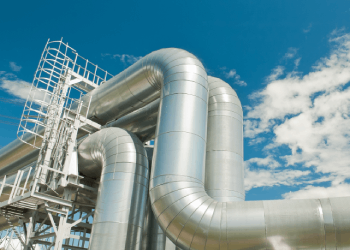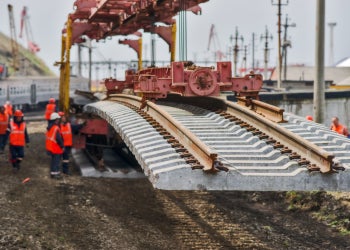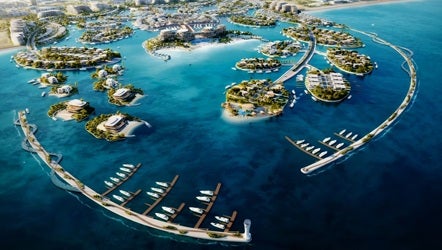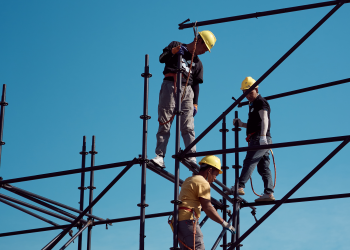Local firms rise in GCC Power Developer Ranking
24 September 2024

Two Saudi Arabia-headquartered firms have joined Acwa Power in the top 10 of MEED’s 2024 GCC Power Developer Ranking.
Aljomaih Energy & Water Company and Ajlan & Bros have entered the list, occupying the sixth and ninth spots, respectively.
The latest developer ranking included a survey of 109 privately owned and financed power generation plants in the six GCC states, including those with attached water desalination facilities. These plants have a collective gross electricity generation capacity of approximately 112,400MW.
These projects include seven solar, two wind and two gas-fired plants, as well as one industrial steam and cogeneration facility, with a total combined gross capacity of 19,635MW, for which contracts were awarded between September 2023 and August 2024.
Of the total capacity awarded during the 12-month period, solar photovoltaic (PV) and wind capacity accounted for 58%, or 11,400MW. Three solar PV contracts with a total capacity of 5,500MW, directly negotiated between Saudi Arabia’s Public Investment Fund (PIF) and a team led by Riyadh-headquartered Acwa Power, comprised nearly half of the awarded renewable IPP capacity.
These three contracts, along with a fourth for the development and operation of the 3,800MW Taiba 1 and Qassim 1 combined-cycle gas turbine (CCGT) IPP, helped boost Acwa Power’s dominance over its competitors.
Acwa Power's 35.1% stake in the 2,000MW Haden, the 2,000MW Muwayh and 1,500MW Al-Khushaybi solar PV projects, and its 40% share in Taiba 1 and Qassim 1, increased the company's total net capacity by 3,200MW, up 23% from last year’s 13,340MW. This figure takes into account the dilution of its shares in Rabigh Arabian Water & Electricity Company. As a result of the contracts it won, Acwa Power’s gross capacity also rose by 8,800MW to reach a total of 45,150MW.
Acwa Power has occupied the top spot in MEED’s GCC Power Developer Ranking in terms of net capacity since 2021, but it overtook its main rival, French utility developer and investor Engie, in terms of gross capacity only the following year.
Excluding the capacity of the directly negotiated solar IPP contracts that Acwa Power secured with the PIF in the past
three years does not change the company’s dominant position in the ranking, although it decreases its net and gross capacities by 25% and 24%, respectively.
Contenders
With no new contracts won, Engie still managed to retain second place in the ranking, with a net capacity of close to 8,000MW.
The successful bids of a team comprising Japan’s Marubeni Corporation and Ajlan & Bros for the contracts to develop and operate the 600MW Al-Ghat and 500MW Waad Al-Shamal wind schemes in Saudi Arabia increased Marubeni’s net capacity to 4,257MW, up 555MW compared to the previous year.
As with Engie, Japan’s Mitsui did not win any new contracts but retained its fourth place in the ranking, just above EDF, which climbed two positions to claim this year’s fifth spot and registered a net capacity that nearly doubled to reach 2,047MW.
EDF’s impressive performance accrued from its equities in three contracts: the 1,100MW Hinakiyah solar PV and the 3,960MW Taiba 2 and Qassim 2 CCGT projects in Saudi Arabia, and Abu Dhabi’s 1,500MW Al-Ajban solar PV scheme.
EDF knocked Japanese developer Sumitomo down the ranking; it landed in the seventh spot this year. Saudi Arabia’s Aljomaih Energy & Water Company – which was not part of the top 10 last year – rose past Sumitomo to claim sixth position.
Aljomaih’s 30% shareholding in the Taiba 2 and Qassim 2 IPP increased its net capacity by close to 1,200MW from just 775MW in the previous 12-month period.
Previously ranked sixth, Japan’s Jera fell to eighth place, despite having won the contract to develop the Najim cogeneration plant catering to Saudi Arabia’s Amiral petrochemicals complex, which it secured along with Abu Dhabi National Energy Company (Taqa).
Below Jera in the ranking is Ajlan & Bros, which is Marubeni’s partner for the contract to develop the Al-Ghat and Waad Al-Shamal wind IPPs. Ajlan is also understood to have taken a 30% stake in the consortium that won the contract to develop the Taiba 2 and Qassim 2 CCGT project.
China’s Jinko Power rounded out the top 10. It led the team that won the contract to develop the 400MW Tubarjal solar IPP in Saudi Arabia in November last year.
Local developers
The rise of Aljomaih and Ajlan & Bros, which led to South Korea’s Korea Electric Power Corporation (Kepco) and Singapore’s Sembcorp dropping out of the power developer ranking’s top 10 this year, confirms the improving profile of regional utility developers.
The resurgence of gas-fired power generation IPPs – in part due to Saudi Arabia’s liquid fuel displacement programme and the overall demand for baseload to address rising renewable energy capacity – is helping local developers to strengthen their footing.
“The reduced interest from European and Japanese contractors in bidding for gas-fired power generation projects could present an opportunity for local developers and investors,” says a senior executive with an international developer.
“As these firms are less constrained by their 2040-50 net-zero targets, they might focus on efficiency and quick deployment rather than on adhering to decarbonisation timelines, allowing for more flexibility in CCGT projects.”
The fact that only two teams submitted bids for the contracts to develop the next pair of CCGT IPPs in Saudi Arabia supports this observation. Similarly, Qatar’s General Electricity & Water Corporation (Kahramaa) received only one bid from a team led by Sumitomo for the contract to develop the Facility E independent water and power producer (IWPP) project earlier this year.
Conscious of its own net-zero targets, and those of its partners, Abu Dhabi state utility Emirates Water & Electricity Company (Ewec) is adopting a slightly different approach for its next CCGT project in Taweelah by announcing that a carbon-capture facility will be installed as part of the project once such solutions become commercially viable.
In addition, the power-purchase agreement (PPA) for Taweelah C is expected to expire by 2049, making it several years shorter than previous PPAs and in line with the UAE's plan to reach net-zero carbon emissions by 2050.
So far, the market has responded positively, with nine companies having met Ewec’s prequalification requirements for Taweelah C.
However, the scale and volume of gas and renewable energy projects planned by Saudi Arabia, which has said it could procure up to 20GW of renewable energy capacity annually starting this year, is expected to continue to boost the net capacity of local developers and their less net-zero-constrained counterparts for the foreseeable future.
There is also an expectation that the exclusion of Acwa Power from the latest round of tenders for Saudi Arabia’s National Renewable Energy Programme (NREP) could further open up opportunities for other companies, regardless of their origin and net-zero targets.
Tariffs
There are mixed expectations in terms of how levelised electricity costs (LCOE) will behave over the next 12 months. Compared to the preceding decade, when unsubsidised renewable energy production costs consistently and sharply declined, tariffs have become less predictable since 2022.
In the region, solar PV tariffs in particular have trended upward since Acwa Power offered to develop the Shuaibah 1 solar IPP scheme for $cents 1.04 a kilowatt-hour (kWh) in 2020-21.
These tariffs have remained highly competitive relative to those seen in other, less renewable energy-intense regions, however, disincentivising some developers that felt they could not compete on price.
The next six to 12 months could prove decisive, according to one industry expert.
“It is possible that the surge in renewable projects could limit the availability of competent engineering, procurement and construction (EPC) contractors. The combination of aggressive national targets and competition for EPC services may drive up prices and slow project timelines,” the Dubai-based executive tells MEED.
“With raw materials and commodity prices trending downward, it's feasible that renewable energy tariffs could remain low in the short term. However, sustained record-low tariffs will also depend on the availability of financing, local regulations and grid integration costs.”
The LCOE trend for gas-fired power generation schemes seems more predictable.
According to the executive, the limited capacity of original equipment manufacturers, particularly for turbines and other key components of CCGT plants, will likely push tariffs up over the next 12 months.
“Limited availability of high-efficiency equipment will increase procurement costs and construction timelines, influencing the overall project cost.”
This extends to CCGTs incorporating carbon capture, where the LCOE will likely increase due to additional capital and operational expenses. “Whether these costs are absorbed through renegotiation or passed on to the state offtaker will depend on the power-purchase agreement structure,” he says.
Exclusive from Meed
-
 SLB passes evaluation for Kuwait upstream project
SLB passes evaluation for Kuwait upstream project12 December 2025
-
 Dana Gas makes onshore discovery in Egypt
Dana Gas makes onshore discovery in Egypt12 December 2025
-
 SAR to tender new phosphate rail track section in January
SAR to tender new phosphate rail track section in January12 December 2025
-
 Dar Global to develop $4.2bn Oman mixed-use project
Dar Global to develop $4.2bn Oman mixed-use project10 December 2025
-
 Contract award nears for Saudi Defence Ministry headquarters
Contract award nears for Saudi Defence Ministry headquarters10 December 2025
All of this is only 1% of what MEED.com has to offer
Subscribe now and unlock all the 153,671 articles on MEED.com
- All the latest news, data, and market intelligence across MENA at your fingerprints
- First-hand updates and inside information on projects, clients and competitors that matter to you
- 20 years' archive of information, data, and news for you to access at your convenience
- Strategize to succeed and minimise risks with timely analysis of current and future market trends

Related Articles
-
 SLB passes evaluation for Kuwait upstream project
SLB passes evaluation for Kuwait upstream project12 December 2025
The US-based oilfield services company SLB, formerly Schlumberger, has passed the technical bid evaluation for a major project to develop Kuwait’s Mutriba oil field.
The Houston-headquartered company was the only bidder to pass the technical evaluation for the Mutriba integrated project management (IPM) contract.
The minimum passing technical evaluation score was 75%.
The full list of bidders was:
- SLB (US): 97%
- Halliburton (US): 72%
- Weatherford (US): 61.5%
The decision was finalised at a meeting of the Higher Purchase Committee (HPC) of state-owned Kuwait Petroleum Corporation (KPC) on 20 November 2025.
According to a document published earlier this year by KOC, the IPM tender for the Mutriba field aims to “accelerate production through a comprehensive study that includes economic feasibility evaluation, well planning and long-term sustainability strategies”.
The field was originally discovered in 2009.
Commercial production from the Mutriba field started earlier this year, on 15 June, after several wells were connected to production facilities.
The field is located in a relatively undeveloped area in northwest Kuwait and spans more than 230 square kilometres.
The oil at the Mutriba field has unusually high hydrogen sulfide content, which can be as much as 40%.
This presents operational challenges requiring specialised technologies and safety measures.
In order to start producing oil at the field, KOC deployed multiphase pumps to increase hydrocarbon pressure and enable transportation to the nearest Jurassic production facilities in north Kuwait.
The company also built long-distance pipelines stretching 50 to 70 kilometres, using high-grade corrosion-resistant materials engineered to withstand the high hydrogen sulfide levels and ensure long-term reliability.
KOC also commissioned the Mutriba long-term testing facility in northwest Kuwait, with a nameplate capacity of around 5,000 barrels of oil a day (b/d) and 5 million standard cubic feet of gas a day (mmscf/d).
Once this facility was commissioned, production stabilised at 5,000 b/d and 7 mmscf/d.
In documents published earlier this year, KOC said that starting production from the field had “laid a solid foundation” for the IPM contract by generating essential reservoir and surface data that will guide future development.
Future output from the field is expected to range between 80,000 and 120,000 b/d, in addition to approximately 150 mmscf/d of gas.
https://image.digitalinsightresearch.in/uploads/NewsArticle/15235579/main.png -
 Dana Gas makes onshore discovery in Egypt
Dana Gas makes onshore discovery in Egypt12 December 2025
Register for MEED’s 14-day trial access
UAE-based Dana Gas has made an onshore gas discovery in Egypt’s Nile Delta area, according to a statement from the company.
The discovery was made by the drilling of the North El-Basant 1 exploratory well, and initial well results indicate estimated reserves of 15-25 billion cubic feet of gas.
Production from the reserve is expected to exceed 8 million cubic feet a day (cf/d) once the well is connected to the national network.
The North El-Basant 1 exploratory well was the fourth well in a campaign of 11 development and exploration wells.
The campaign is being executed as part of the company’s $100m investment programme to support domestic gas production, increase reserves and meet growing energy demand.
Earlier this year, Dana Gas completed the drilling of three wells, adding 10 million cf/d.
The programme is expected to increase long-term production and add approximately 80 billion cubic feet of recoverable gas reserves, according to Dana Gas.
Dana Gas expects to start drilling the fifth well in the programme, the Daffodil exploration well, in the first week of January 2026.
Richard Hall, the chief executive of Dana Gas, said: “The latest drilling success reinforces the value of our investment programme in Egypt and highlights the significant remaining potential within the Nile Delta.”
He added: “By increasing local gas production, the programme will help reduce Egypt’s reliance on imported liquefied natural gas (LNG) and fuel oil and is expected to generate more than $1bn in savings for the national economy over time.”
Previously, Dana Gas signed an agreement with state-owned Egyptian Natural Gas Holding Company (EGas) to secure additional acreage under improved fiscal terms, and to accelerate drilling activity.
Hall said: “We appreciate the strong cooperation from EGas and the ministry, and we remain committed to delivering the majority of our planned programme next year.
“Regular and timely payments from our partners are crucial to sustaining our investment programme in Egypt."
In November, a new gas discovery was made in Egypt’s Western Desert region by Khalda Petroleum Company, a joint venture of state-owned Egyptian General Petroleum Corporation and US-headquartered Apache Corporation.
Egypt also started gas production from the West Burullus field in the Mediterranean Sea, after connecting the first wells to the national gas grid.
The country is currently pushing to increase gas production in order to meet domestic demand and reduce its import bill.
https://image.digitalinsightresearch.in/uploads/NewsArticle/15235552/main.png -
 SAR to tender new phosphate rail track section in January
SAR to tender new phosphate rail track section in January12 December 2025

Register for MEED’s 14-day trial access
Saudi Arabian Railways (SAR) is expected to float another multibillion-riyal tender to double the tracks on the existing phosphate railway network connecting the Waad Al-Shamal mines to Ras Al-Khair in the Eastern Province.
MEED understands that the new tender – covering the second section of the track-doubling works, spanning more than 150 kilometres (km) – will be issued in January.
The new tender follows SAR’s issuance of the tender for the project's first phase in November, which spans about 100km from the AZ1/Nariyah Yard to Ras Al-Khair.
The scope includes track doubling, alignment modifications, new utility bridges, culvert widening and hydrological structures, as well as the conversion of the AZ1 siding into a mainline track.
The scope also covers support for signalling and telecommunications systems.
The tender notice was issued in late November, with a bid submission deadline of 20 January 2026.
Switzerland-based engineering firm ARX is the project consultant.
MEED understands that these two packages are the first of four that SAR is expected to tender for the phosphate railway line.
The other packages expected to be tendered shortly include the depot and the systems package.
In 2023, MEED reported that SAR was planning two projects to increase its freight capacity, including an estimated SR4.2bn ($1.1bn) project to install a second track along the North Train Freight Line and construct three new freight yards.
Formerly known as the North-South Railway, the North Train is a 1,550km-long freight line running from the phosphate and bauxite mines in the far north of the kingdom to the Al-Baithah junction. There, it diverges into a line southward to Riyadh and a second line running east to downstream fertiliser production and alumina refining facilities at Ras Al-Khair on the Gulf coast.
Adding a second track and the freight yards will significantly increase the network’s cargo-carrying capacity and facilitate increased industrial production. Project implementation is expected to take four years.
State-owned SAR is also considering increasing the localisation of railway materials and equipment, including the construction of a cement sleeper manufacturing facility.
https://image.digitalinsightresearch.in/uploads/NewsArticle/15229624/main.jpg -
 Dar Global to develop $4.2bn Oman mixed-use project
Dar Global to develop $4.2bn Oman mixed-use project10 December 2025
Register for MEED’s 14-day trial access
Saudi Arabia-headquartered real estate developer Dar Global has announced that it will develop a mixed-use project in Muscat at an estimated investment of RO1.6bn ($4.2bn).
Dar Global will co-develop the Muscat Marine, Art & Digital District project with Oman's Art District Real Estate Development Company.
The project will cover an area of over 1.5 million square metres (sq m) and will be developed in several phases over 12 years.
The development will comprise a mix of residential communities, cultural venues, marinas, retail spaces, finance and business parks and hotels.
Dar Global, a subsidiary of Dar Al-Arkan, was one of the first Saudi brands to list on the London Stock Exchange.
Dar Al-Arkan established Dar Global in 2017 to focus on developing projects in the Middle East and Europe, including in Dubai, Qatar, Oman, London and the Costa del Sol in southern Spain.
Dar Global has $12bn-worth of projects under development in six countries: the UAE, Oman, Qatar, Saudi Arabia, the UK and Spain.
It completed three developments – the Urban Oasis and Da Vinci towers in Dubai and the Sidra gated community in Bosnia – in 2023.
The company collaborates with global brands including Missoni, W Hotels, Versace, Elie Saab, Automobili Pagani and Automobili Lamborghini.
In Oman, Dar Global is also developing the Aida project. In May, it awarded a contract to develop the villas and apartments as part of the project.
According to an official statement, the construction works are expected to start immediately and the project is slated for completion in 2026.
The main contract was awarded to local firm Al-Adrak Trading & Contracting.
The latest announcement follows the awarding of contracts in June last year for the development of the first phase of the Aida project.
The Aida project is being developed as a joint venture with Omran Group and the first phase is expected to be completed in 2027.
UK analytics firm GlobalData forecasts that the Omani construction industry will expand at an annual average growth rate of 4.2% in 2025-28. Growth in the country will be supported by rising government investments in renewable energy, the transport infrastructure and the housing sector, all as part of Oman's Vision 2040 strategy.
Growth during the forecast period will also be supported by increasing hospitality sector investments, with the government planning to invest RO11.9bn ($31bn) in tourism development projects by 2040 and supporting the construction of several hospitality projects.
https://image.digitalinsightresearch.in/uploads/NewsArticle/15222694/main.jpg -
 Contract award nears for Saudi Defence Ministry headquarters
Contract award nears for Saudi Defence Ministry headquarters10 December 2025

Saudi Arabia’s Defence Ministry (MoD) is preparing to award the contract to build a new headquarters building, as part of its P-563 programme in Riyadh.
MEED understands that bid evaluation has reached advanced stages and the contract award is imminent.
The MoD issued the tender in April. The commercial bids were submitted in September, as MEED reported.
Located to the northwest of Riyadh, the P-563 programme includes the development of facilities and infrastructure to support the MoD’s broader initiatives under the kingdom’s Vision 2030 strategy.
It covers the construction of:
- A new military city featuring the MoD headquarters, support and logistics facilities, a residential and commercial community and space for future command centres
- A National Defence University with a library, conference centre and academic buildings
- A self-sustaining Joint Forces Command compound located approximately 50 kilometres from the military city
The budget for the entire programme is expected to be $10bn-$12bn.
In September 2023, MEED reported that Spain-headquartered Typsa had won two contracts for the project.
The first contract, worth $11.4m, included data management, geographic information systems management, geotechnical reporting and the preparation of the phase one final traffic report. The contract duration was 270 days from the notice to proceed.
The second contract, valued at $10.8m, involved preparing four conceptual masterplans for the P-563 site. It was set to last 255 days from the notice to proceed.
These followed a $290m consultancy contract awarded to Typsa in March of the same year. The single-award task order covered a three-year base period, with an optional two-year extension.
Typsa’s scope of work included programme management planning, communications, change and quality management and cost and schedule tracking.
It also included design requirements, codes, standards and submission requirements, programme guidance, study integration, risk analysis and management, design reviews and a programme-of-work breakdown plan.
 READ THE DECEMBER 2025 MEED BUSINESS REVIEW – click here to view PDF
READ THE DECEMBER 2025 MEED BUSINESS REVIEW – click here to view PDFProspects widen as Middle East rail projects are delivered; India’s L&T storms up MEED’s EPC contractor ranking; Manama balances growth with fiscal challenges
Distributed to senior decision-makers in the region and around the world, the December 2025 edition of MEED Business Review includes:
> AGENDA 1: Regional rail construction surges ahead> INDUSTRY REPORT 1: Larsen & Toubro climbs EPC contractor ranking> INDUSTRY REPORT 2: Chinese firms expand oil and gas presence> CONSTRUCTION: Aramco Stadium races towards completion> RENEWABLES: UAE moves ahead with $6bn solar and storage project> INTERVIEW: Engie pivots towards renewables projects> BAHRAIN MARKET FOCUS: Manama pursues reform amid strainTo see previous issues of MEED Business Review, please click herehttps://image.digitalinsightresearch.in/uploads/NewsArticle/15222401/main.gif




